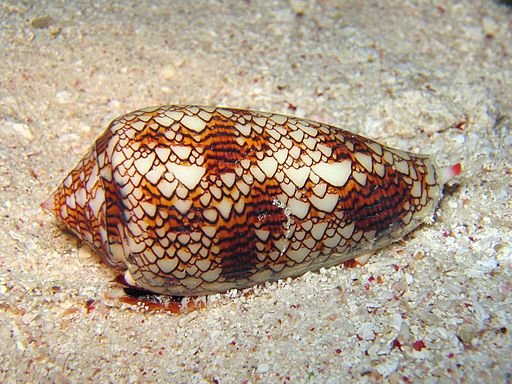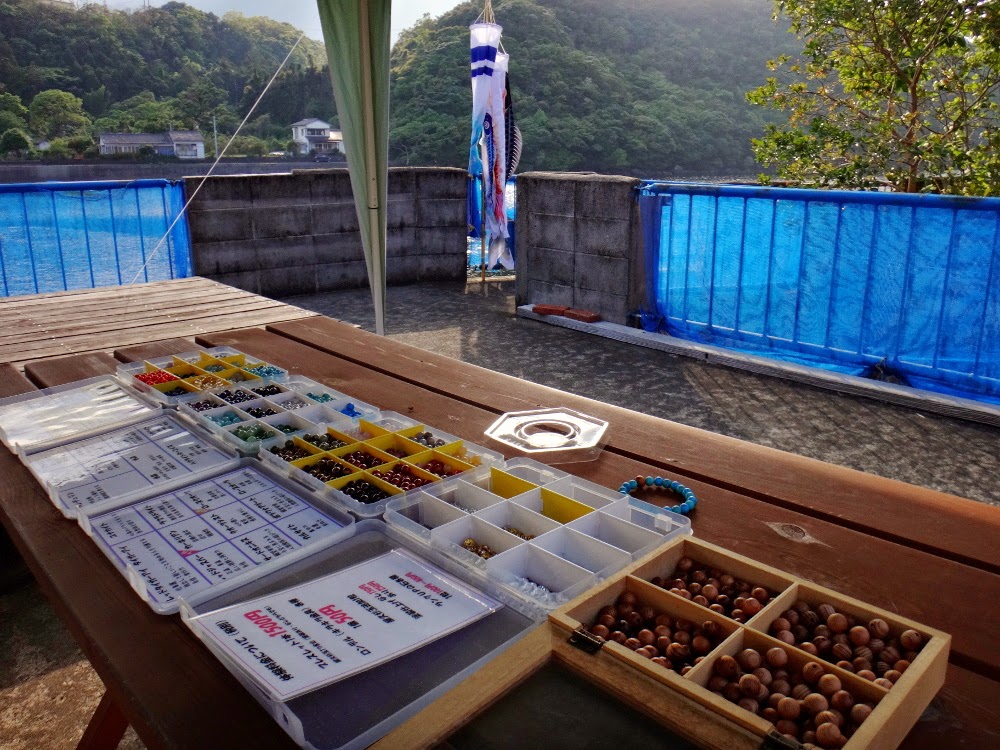Where ever there's beauty, there also lurks danger. No matter where you swim in Yakushima, there are dangers to watch out for: River rapids with recirculating currents, riptides in unregulated beaches, and a myriad of sea creatures. You can minimize the dangers by swimming with others in designated sites, and whether you are snorkeling in open water, splashing around with the kids in a swimming area, or just gazing into the tide pools, there are some creatures which you may be lucky enough to see, but should definitely avoid touching. If you're not sure, look, but don't touch.
Striped Eel Catfish (Gonzui)
 |
| By Izuzuki (http://www.izuzuki.com/) [CC BY-SA 3.0 (http://creativecommons.org/licenses/by-sa/3.0)], via Wikimedia Commons |
I've put these guys first because they are so common. Schools of little striped fish swimming so tightly together they look like a solid ball often about the size of your head . . . a ball of poisonous spines! Although these are pretty common around the island, I've never had any trouble with them. Just don't try to pet them.
Sea Snakes (Umihebi)
These beautiful blue-and-black striped snakes are usually docile. However, I hear that their venom is as deadly as cobra venom!
Cone Snails (Amboina)
 |
| By Photographer: Richard Ling (richard@research.canon.com.au) (Location: Cod Hole, Great Barrier Reef, Australia) [GFDL (http://www.gnu.org/copyleft/fdl.html) or CC-BY-SA-3.0 (http://creativecommons.org/licenses/by-sa/3.0/)], via Wikimedia Commons |
Shell collectors steer clear of live shells in the cone family. Cones like the textile cone (top) and the geographic cone are infamous for possessing a barb that can stick you with a barb and inject lethal amounts of paralysing venom. Other less famous cones, such as the tulip cone (bottom), should also be avoided.
Lionfish (Minokasago)
 |
| By syu-1 (http://photozou.jp/photo/show/1035073/116196386) [CC BY-SA 2.1 jp (http://creativecommons.org/licenses/by-sa/2.1/jp/deed.en)], via Wikimedia Commons |
Beautiful from a distance. They are considered an invasive species in the Atlantic, and while one solution to the invasion is to eat them, their spines contain venom.
Portuguese Man-of-War (Katsuo no Eboshi)
 |
| See page for author [Public domain], via Wikimedia Commons"><img alt="Portuguese Man-O-War (Physalia physalis) |
I think most of us know to avoid waters where
jellyfish or man-of-war are floating about. Not just the live ones, but also the tentacles of dead man-of-war washed up on the beach after a storm can sting.
Bottom dwellers:
If you're at a sandy swimming beach, these things aren't so much of a problem, but especially if you're snorkeling, you should watch where you put your feet.
Please, folks, don't stand on the coral. This is inconsiderate of living corals, and also dangerous. In case you're worried about getting tired and needing to stand up while snorkeling, why not put some fins on your feet that will help you with propulsion, or at least some old shoes with cushy soles that will keep your feet afloat?
There's a bunch of nasty things you don't want to stand on, and sharp rocks are just the beginning. While some sea urchins are quite a delicacy, none are pleasant to step on. Not always floating frills and tentacles, jellyfish polyps of the genus
Stephanoscyphus may be attached to coral or sponges. What appears to be a placid spot of coral may not be so defenceless. Some things to watch for include
sea fans,
anemones and
bristle worms hidden among the coral.
The Yakushima Environment and Cultural Center book, 屋久島の海辺生き物ガイド, also warns about these two curious creatures which I have not been (un)fortunate enough to meet:
Stonefish (Onidaruma Okaze)
 |
| By David Burdick. (NOAA Photo Library: reef0915) [CC BY 2.0 (http://creativecommons.org/licenses/by/2.0) or Public domain], via Wikimedia Commons |
I'm not sure if I would spot this fish if it was half a meter from my face, but apparently they have poisonous spines that can be deadly if stepped on.
Blue-Ringed Octopus (HyoumonDago)
 |
| David Breneman at en.wikipedia [GFDL (http://www.gnu.org/copyleft/fdl.html), CC-BY-SA-3.0 (http://creativecommons.org/licenses/by-sa/3.0/) or CC BY-SA 2.5-2.0-1.0 (http://creativecommons.org/licenses/by-sa/2.5-2.0-1.0)], from Wikimedia Commons |
Beautiful, yes, but their saliva is
oh so deadly.
Still want to go swimming? Of course you do! With warm waters and a mix of tropical and cold water fish, Yakushima is a great place to explore the ocean. Just remember, don't touch things if you don't know what they are!
*Copyright note: I've used several images from the Wikimedia Commons. Images without listed copyright information are my own.
 You'll find little gift shops popping up all around Yakushima, but few of them are smaller than Pukari, whose little blue door opened in 2012. One can hardly stay in Anbo without taking a short stroll up the river, and on the way you are likely to stumble across a little blue sign pointing up a staircase towards Pukari-Do (ぽかり堂). There you'll find a little white shack with the blue door flung open in good weather, and when you
peak inside, the owner will throw on some light music and you'll wonder
how so much charm can fit in so small a space.
You'll find little gift shops popping up all around Yakushima, but few of them are smaller than Pukari, whose little blue door opened in 2012. One can hardly stay in Anbo without taking a short stroll up the river, and on the way you are likely to stumble across a little blue sign pointing up a staircase towards Pukari-Do (ぽかり堂). There you'll find a little white shack with the blue door flung open in good weather, and when you
peak inside, the owner will throw on some light music and you'll wonder
how so much charm can fit in so small a space.  Especially convenient for folks without a car, you'll find aromas by Yawaraka, Yakushima original T-shirts, CDs, half-aprons featuring the Honbo Shochu brewed a few kilometers away, and beaded jewelry along with pictures, postcards, trinkets, and some more standard Yakushima products. There is even a canopy set up outside so you can string your own beaded jewelry as you gaze across the river. Gift-shopping was never so relaxing!
Especially convenient for folks without a car, you'll find aromas by Yawaraka, Yakushima original T-shirts, CDs, half-aprons featuring the Honbo Shochu brewed a few kilometers away, and beaded jewelry along with pictures, postcards, trinkets, and some more standard Yakushima products. There is even a canopy set up outside so you can string your own beaded jewelry as you gaze across the river. Gift-shopping was never so relaxing!










































